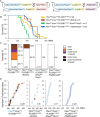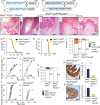Plexin-B1 Mutation Drives Metastasis in Prostate Cancer Mouse Models
- PMID: 36936664
- PMCID: PMC10019359
- DOI: 10.1158/2767-9764.CRC-22-0480
Plexin-B1 Mutation Drives Metastasis in Prostate Cancer Mouse Models
Abstract
Metastatic prostate cancer is essentially incurable and is a leading cause of cancer-related morbidity and mortality in men, yet the underlying molecular mechanisms are poorly understood. Plexins are transmembrane receptors for semaphorins with divergent roles in many forms of cancer. We show here that prostate epithelial cell-specific expression of a mutant form of Plexin-B1 (P1597L) which was identified in metastatic deposits in patients with prostate cancer, significantly increases metastasis, in particular metastasis to distant sites, in two transgenic mouse models of prostate cancer (PbCre+Ptenfl /flKrasG12V and PbCre+Ptenfl /flp53fl/ fl ). In contrast, prostate epithelial cell-specific expression of wild-type (WT) Plexin-B1 in PbCre+Ptenfl /flKrasG12V mice significantly decreases metastasis, showing that a single clinically relevant Pro1597Leu amino-acid change converts Plexin-B1 from a metastasis-suppressor to a metastasis-promoter. Furthermore, PLXNB1P1597L significantly increased invasion of tumor cells into the prostate stroma, while PLXNB1WT reduced invasion, suggesting that Plexin-B1 has a role in the initial stages of metastasis. Deletion of RhoA/C or PDZRhoGEF in Ptenfl /flKrasG12VPLXNB1P1597L mice suppressed metastasis, implicating the Rho/ROCK pathway in this phenotypic switch. Germline deletion of Plexin-B1, to model anti-Plexin-B1 therapy, significantly decreased invasion and metastasis in both models. Our results demonstrate that Plexin-B1 plays a complex yet significant role in metastasis in mouse models of prostate cancer and is a potential therapeutic target to block the lethal spread of the disease.
Significance: Few therapeutic targets have been identified specifically for preventing locally invasive/oligometastatic prostate cancer from becoming more widely disseminated. Our findings suggest Plexin-B1 signaling, particularly from the clinically relevant P1597L mutant, is such a target.
© 2023 The Authors; Published by the American Association for Cancer Research.
Figures







Similar articles
-
The metastasis-promoting P1597L mutation in PlexinB1 enhances Ras activity.BMC Cancer. 2024 Aug 13;24(1):1004. doi: 10.1186/s12885-024-12762-0. BMC Cancer. 2024. PMID: 39138404 Free PMC article.
-
A functional role for semaphorin 4D/plexin B1 interactions in epithelial branching morphogenesis during organogenesis.Development. 2008 Oct;135(20):3333-43. doi: 10.1242/dev.019760. Epub 2008 Sep 17. Development. 2008. PMID: 18799546
-
Plexin B1 suppresses c-Met in melanoma: a role for plexin B1 as a tumor-suppressor protein through regulation of c-Met.J Invest Dermatol. 2010 Jun;130(6):1636-45. doi: 10.1038/jid.2010.13. Epub 2010 Feb 18. J Invest Dermatol. 2010. PMID: 20164843 Free PMC article.
-
Direct interaction of Rnd1 with Plexin-B1 regulates PDZ-RhoGEF-mediated Rho activation by Plexin-B1 and induces cell contraction in COS-7 cells.J Biol Chem. 2003 Jul 11;278(28):25671-7. doi: 10.1074/jbc.M303047200. Epub 2003 May 1. J Biol Chem. 2003. PMID: 12730235
-
The Plexin-B family and its role in cancer progression.Histol Histopathol. 2014 Feb;29(2):151-65. doi: 10.14670/HH-29.151. Epub 2013 Sep 17. Histol Histopathol. 2014. PMID: 24043639 Review.
Cited by
-
PlexinD1 is a driver and a therapeutic target in advanced prostate cancer.EMBO Mol Med. 2025 Feb;17(2):336-364. doi: 10.1038/s44321-024-00186-z. Epub 2025 Jan 2. EMBO Mol Med. 2025. PMID: 39748059 Free PMC article.
-
Computation model predicts Rho GTPase function with the Plexin Transmembrane receptor GAP activity on Rap1b via dynamic allosteric changes.bioRxiv [Preprint]. 2025 May 14:2025.03.13.643120. doi: 10.1101/2025.03.13.643120. bioRxiv. 2025. Update in: Protein Sci. 2025 Jul;34(7):e70196. doi: 10.1002/pro.70196. PMID: 40462934 Free PMC article. Updated. Preprint.
-
The metastasis-promoting P1597L mutation in PlexinB1 enhances Ras activity.BMC Cancer. 2024 Aug 13;24(1):1004. doi: 10.1186/s12885-024-12762-0. BMC Cancer. 2024. PMID: 39138404 Free PMC article.
-
Computational model predicts function of Rho-GTPase binding for plexin receptor GAP activity on Rap1b via dynamic allosteric changes.Protein Sci. 2025 Jul;34(7):e70196. doi: 10.1002/pro.70196. Protein Sci. 2025. PMID: 40545673 Free PMC article.
References
-
- Tamagnone L, Comoglio PM. Signalling by semaphorin receptors: cell guidance and beyond. Trends Cell Biol 2000;10:377–83. - PubMed
-
- Kruger RP, Aurandt J, Guan KL. Semaphorins command cells to move. Nat Rev Mol Cell Biol 2005;6:789–800. - PubMed
-
- Swiercz JM, Worzfeld T, Offermanns S. ErbB-2 and met reciprocally regulate cellular signaling via plexin-B1. J Biol Chem 2008;283:1893–901. - PubMed
Publication types
MeSH terms
Substances
LinkOut - more resources
Full Text Sources
Medical
Research Materials
Miscellaneous

